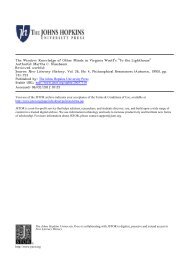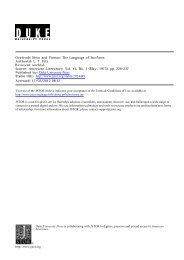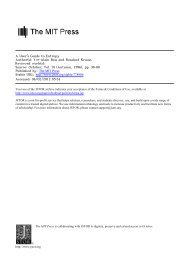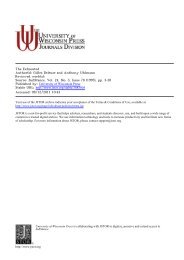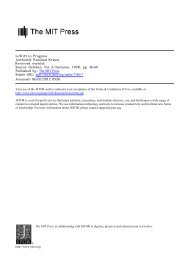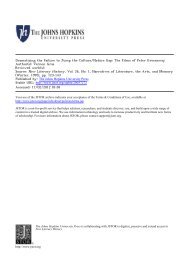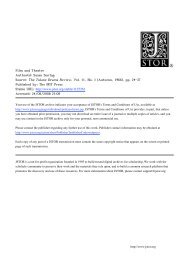Earthwords Author(s): Craig Owens Reviewed work(s ... - engl328
Earthwords Author(s): Craig Owens Reviewed work(s ... - engl328
Earthwords Author(s): Craig Owens Reviewed work(s ... - engl328
You also want an ePaper? Increase the reach of your titles
YUMPU automatically turns print PDFs into web optimized ePapers that Google loves.
<strong>Earthwords</strong><br />
<strong>Author</strong>(s): <strong>Craig</strong> <strong>Owens</strong><br />
<strong>Reviewed</strong> <strong>work</strong>(s):<br />
Source: October, Vol. 10 (Autumn, 1979), pp. 120-130<br />
Published by: The MIT Press<br />
Stable URL: http://www.jstor.org/stable/778632 .<br />
Accessed: 19/11/2011 09:18<br />
Your use of the JSTOR archive indicates your acceptance of the Terms & Conditions of Use, available at .<br />
http://www.jstor.org/page/info/about/policies/terms.jsp<br />
JSTOR is a not-for-profit service that helps scholars, researchers, and students discover, use, and build upon a wide range of<br />
content in a trusted digital archive. We use information technology and tools to increase productivity and facilitate new forms<br />
of scholarship. For more information about JSTOR, please contact support@jstor.org.<br />
http://www.jstor.org<br />
The MIT Press is collaborating with JSTOR to digitize, preserve and extend access to October.
<strong>Earthwords</strong>*<br />
The Writings of Robert Smithson: Essays with Illustrations. Edited by Nancy<br />
Holt, with an introduction by Philip Leider, designed by Sol LeWitt. New York:<br />
New York University Press, 1979.<br />
CRAIG OWENS<br />
The strata of the Earth is a jumbled museum.<br />
Embedded in the sediment is a text ...<br />
-"A Sedimentation of Mind: Earth Projects"<br />
Precisely at the center (page 67 of 133) of the first section of this collection of<br />
Robert Smithson's writings, we encounter the following words on language,<br />
worthy of Borges or Barthes:<br />
In the illusory babels of language, an artist might advance specifically<br />
to get lost, and to intoxicate himself in dizzying syntaxes, seeking odd<br />
intersections of meaning, strange corridors of history, unexpected<br />
echoes, unknown humors, or voids of knowledge ... but this quest is<br />
risky, full of bottomless fictions and endless architectures and counter-<br />
architectures... at the end, if there is an end, are perhaps only<br />
meaningless reverberations.<br />
This passage, the opening of the essay "A Museum of Language in the Vicinity of<br />
Art," contains a number of topoi explored in Smithson's art: history, fiction (the<br />
fictive explanation of the origin of the Great Salt Lake, from which the form of the<br />
Spiral Jetty was derived), architecture (Smithson's obsession with construction),<br />
and counter-architecture (or de-architecture, "entropy made visible," as in the<br />
Partially Buried Woodshed). Yet here they radiate from a meditation on the<br />
labyrinthine, abyssal nature of language, which therefore appears to occupy both<br />
* This word is Smithson's, and it describes the alphabetic chasms at the conclusion of Edgar<br />
Allan Poe's Narrative of Arthur Gordon Pym: "His descriptions of chasms and holes seem to verge on<br />
proposals for 'earthwords.' The shapes of the chasms themselves become 'verbal roots' that spell out<br />
the difference between darkness and light. Poe ends his mental maze with the sentence-' I have graven<br />
it within the hills and my vengeance upon the dust within the rock.'" (p. 88.)<br />
Robert Smithson. Strata: A Geophotographic Fiction<br />
(detail). 1972.
PERM IN RUSSIA. EVAPORATION CAUSES LAND TO SHRINK. CONTINENTAL DRIFT. A DRAWING OF THE SKULL OF THE REPTILE ELGINIA (RELATED TO<br />
lOM PERMIAN SANDSTONE IN ELGIN, N.E. SCOTLAND, DRAWN TO ONE-QUARTER NATURAL SIZE). THROUGH THE EYES OF DIMETRODON. PERMIAN ICE AGE.<br />
ING MOVEMENTOF GLACIERSIS DUE TO THE PROPERTIES OFICE ITSELFAND ISASSOCIATED WITH THE PERIODICACCUMULATIONAND REMOVAL OF ELASTIC<br />
YSTALLINEAGGREGATE (P.A. SHUMSKI). HOT DESERT CONDITIONS. NOTES REGARDING FORAMINIFERA. REMAINS OF SLOWWADDLING CREATURES FOUND IN<br />
I AFRICA. SEAS WERE CUT-OFF FROM THE OCEAN, UNTIL THEY BECAME INCREASINGLY SALINE. DRASTIC CHANGES OF THE LANDSCAPE TAKE PLACE. A VOLCANO<br />
TTON IS A SPIRACLE TO A SUBTERRANEAN FURNACE. FANTASTIC IDEAS WERE LATER CAST ASIDE BY THE PLUTONISTS. SOLIDIFIES IN GRANITE. FAUST SAYS,<br />
'.... THE NEPTUNIAN THEORY. THE SYMMETRY OF THE EARTH WAS THOUGHT TO BE SPOILED. MODERN ORDERS OF INSECTS EMERGE. A SPIRALLY COILED BAND<br />
ED TO HELICOPRION. DWARF FAUNA. ONE SENTENCE DEVOTED TO INSECTS IN A CHAPTER ON THE PERMIAN PERIOD. STEREOSCOPIC VIEWS OF THE GUADALOUPE<br />
"HANGING LIGHT OVER RECONSTRUCTIONS OF DECIDUOUS TREES. SNAPSHOTS OF POISON GAS. DIORAMA OF ASH HEAPS. DAGUERREOTYPE SHOWING VAST<br />
AND GYPSUM. EQUATOR IN OKLAHOMA. SPOILED PHOTOGRAPHS OF SAND DUNES. PHOTOMICROGRAPHIC STUDIES OF FOSSIL FROST. AERIAL PHOTOGRAPHS OF<br />
TIGRAPHIC MAP OF OIL DEPOSITS. MISPLACED BOUNDARIES. SHIFTS IN POLAR AXIS RECORDED. EVAPORATION OF SOUTHERN HEMISPHERE. MARATHON<br />
IED. JOURNALS DEVOTED TO RADIATION DAMAGE. UNDEVELOPED FILM OF DRY LAND MASS. NEGATIVES OF SHELLY ORGANISMS. A BOOK ON EDAPHOSAURUS.<br />
'ERMIAN PRAIRIES.<br />
GEOGRAPHY OF THE LOWER CARBONIFEROUS PERIOD SHOWN ON AN OVAL MAP, WITH BLACK DOTS SYMBOLIZING LAND PLANTS. SLUG-LIKE CREATURES GLIDE<br />
IITES. TERRIGENOUS CLASTIC SEDIMENTS EXTENDED TO A LINE PASSING WEST OF MICHIGAN. EARTH WARPAGE. PHOTOGRAPH OF LIMESTONES NEAR BLOOMING-<br />
'URE IS NOT THE STARTING POINT. ALL ROUND THE COAST THE LANGUID AIR DID SWOON... (TENNYSON). PURELY STATIC SHAPES, CLUMPS GLIMPSED THROUGH<br />
PS. THE BRITISH MUSEUM BUILT 1824.THE GLYPTOTHEKIN MUNICH 1816-1834.ASDECAYAND DEATH OVERTOOK THESE FORESTGIANTS THEYEVENTUALLY<br />
'MUDAND OOZE SURROUNDING THEM (CHARLES R. KNIGHT). THE IMMUTABLE CALM IN THE STEAMING SWAMPS. THINGS FAIL TO APPEAR. WORDS SINKING INTO<br />
IE. COLLECTING THE FOSSIL AND SENDING IT TO THE MUSEUM IS ONL YPART OF THESTORY (EDWIN H. COLBERT). A CAMERA OBSCURA REPRODUCES A PALEO-<br />
E SPLITTING OF MARINE BEDS. ERODED OUT. DIAGRAM SHOWING EUSTATIC MOVEMENT-RISE AND FALL OF SEA LEVEL OF 100 FEET IN 400,000 YEARS. EPEIRO-<br />
'SIN THE MUSEUM-URGE THAT OUR LEARNING SHOWS A FACE TURNED TOWARDS THE THINGS OF DEATH (ERNST JUNGER). A HEAP BETWEEN FORGETFULNESS<br />
.CONSTRUCTION OF AN EARLY CARBONIFEROUS (MISSISSIPPIAN) SEA AS IN NORTHWESTERN INDIANA. (THE SMITHSONIAN INSTITUTION). IN THESENATURAL<br />
FHE CANADIAN APPALACHIAN REGION. UNSTABLE CONTINENTS. SEDIMENTS ON THE EAST SHORE OF THE BAY OF FUNDY AT JOGGINS, NOVA SCOTIA. SOUNDLESS<br />
LIGHT. AQUATINT ENGRAVINGS OF FOSSILS.<br />
)F PEBBLES, SAND AND MUD. DEVONSHIRE....APPARENTL YTHEWRECK OFSOME GIGANTIC STRUCTURES OFART.. (POE). THE WORLD THROUGH THE EYES OF<br />
FISH. POLISHED PIECES OF SILICA ROCK. FUNGAL THREADS AND RESTING SPORES. SUNSHINE ON THE PETRIFIED DEPOSITS. A LAKE LOST UNDER THE DEBRIS.<br />
SIL FOREST EXHIBITED IN A DIORAMA IN THE NEW YORK STATE MUSEUM. EOSPERMATOPERIS IS PROMINENT. MOSS. ANTERIOR MEMORIES. LAYER UPON<br />
- INFORMATION GAINED FROM THE COLLECTING AND PREPARING OF FOSSILS IS MADE A VAILABLE THROUGH THE PRINTED PAGE, ASSEMBLAGE SPECIMENS IS<br />
F OFMEANINGLESS JUNK (EDWIN H. COLBERT). A DOUBT WHICH TURNS TO NEGATION, BUT FEIGNED NEGATION. DENDROIDS AND GRAPTOLITES DISAPPEAR.<br />
ILATES. A MODEL SHOWING HOW A VOLCANO ERUPTS. TREE FERNS DECAY INTO FLORA CEMETERIES. RECONSTRUCTION OF LATE DEVONIAN SEA BOTTOM IN<br />
122<br />
OCTOBER<br />
the literal and the thematic center of the book.'<br />
"A Museum of Language" is, in fact, a description of what occurs when<br />
language comes to occupy the center. This text about language is thus also about<br />
the notion of the center, specifically, the dialectical relationship between center<br />
and circumference to which Smithson's non-sites were also addressed. In an<br />
interview, Smithson described the non-site, which catapults the mind out to "the<br />
unfocused fringe" where it "loses its boundaries and a sense of the oceanic<br />
pervades," as the center, and the site itself as the fringe or edge. (p. 176.) Moreover,<br />
in a footnote appended to his essay on the Spiral Jetty, he identified the non-site as<br />
a "net<strong>work</strong> of signs ... discovered as you go along" (p. 115.)-that is, as a text. If<br />
the non-site is also a text, "A Museum of Language" is also a non-site; it thus<br />
propels us outward to the peripheries of Smithson's writings-circumscribed by<br />
the 1965 essay on Donald Judd and the essay on Central Park, "Frederick Law<br />
Olmsted and the Dialectical Landscape," published five months before its author's<br />
death in July 1973-and beyond, to his <strong>work</strong>s.<br />
Whenever Smithson invokes the notion of the center, however, it is to<br />
describe its loss. The non-site is only a vacant reflection of the site; "A Museum of<br />
Language" reveals absence at the center-of Roger Corman's films (his actors<br />
reflect the empty center"), Ad Reinhardt's Jokes, suburban sprawl, and finally the<br />
dots on Buckminster Fuller's World Energy Map, centers signifying "a concentra-<br />
tion or dilation of an infinite expanse of spheres of energy":<br />
Yet the dot evades our capacity to find its center. Where is the central<br />
point, axis, pole, dominant interest, fixed position, absolute structure,<br />
or decided goal? The mind is always being hurled towards the outer<br />
edge into intractable trajectories that lead to vertigo. (p. 78.)<br />
Paradoxically, the concept of a center can occur only within language; at the same<br />
time, language, which proposes the potentially infinite substitution of elements at<br />
the center, destroys all possibility of securely locating any center whatsoever. Thus<br />
what is described by Smithson in this text is that dizzying experience of decenter-<br />
ing which occurred "at the moment when language invaded the universal<br />
problematic, the moment when, in the absence of a center or origin, everything<br />
became discourse."2 If this collection of Smithson's writings testifies to anything<br />
in our present culture, it is to the eruption of language into the field of the visual<br />
arts, and the subsequent decentering of that field-a decentering in which these<br />
texts themselves play a crucial part.<br />
All of Smithson's <strong>work</strong> effected a radical dislocation of art, which was<br />
removed from its locus in the museum and gallery to remote, inaccessible<br />
1. The two sections which follow, the first devoted to interviews, the second to previously<br />
unpublished texts, are essentially appendices to the first, devoted to Smithson's published texts, which<br />
therefore constitute the book per se.<br />
2. Jacques Derrida, "Structure, Sign and Play in the Discourse of the Human Sciences," Writing<br />
and Difference, trans. Alan Bass, Chicago, University of Chicago Press, 1978, p. 280.
<strong>Earthwords</strong><br />
locations. This displacement is not only geographic, but economic as well: the<br />
"value" of the <strong>work</strong> of art is no longer determined by its status as a portable<br />
commodity; it is now the <strong>work</strong> itself which bestows value (upon the depreciated<br />
site where it is installed). Physical decentering is also one theme of his <strong>work</strong>: the<br />
spectator's experience of the Spiral Jetty, for example, is "one of continually being<br />
decentered within the great expanse of lake and sky."3 Yet "A Museum of<br />
Language" describes what is perhaps the most significant displacement of all-<br />
that of art from the visual to the verbal field. For this is in fact a collocation of<br />
artists who write: Dan Flavin, Carl Andre, Robert Morris, Donald Judd, Sol<br />
LeWitt....<br />
That all of these artists are minimalists is a point to which we must return,<br />
since the proliferation of artists' writings in the 1960s is clearly to be connected<br />
with minimalism. For the moment, however, I want to concentrate on the fact that<br />
all are sculptors (despite the extremely incisive argument which questions the<br />
degree to which their production can be assimilated to the rational category<br />
"sculpture").4 Painting and writing share a common origin in inscription;<br />
sculpture, however, involved as it is in the experience of three-dimensional space,<br />
could not seem more distant from language-linear, two-dimensional, located at<br />
the intersection of two axes (of selection and combination) which describe a plane.<br />
Yet Smithson regards language as something solid and obdurate, a three-<br />
dimensional projection: "My sense of language is that it is matter and not ideas."<br />
(p. 104.) Aping Pascal, he writes: "Language becomes an infinite museum whose<br />
center is everywhere and whose limits are nowhere." (p. 67.) Not only does this<br />
metaphrase spatialize language by substituting it for a geometric solid, Pascal's<br />
infinite sphere; it also mirrors the eclipse of Nature by language which lies at the<br />
root of our modernity (Pascal: "Nature is an infinite sphere . . .").5<br />
Smithson's perception of language as substantial characterizes his manipu-<br />
lation of its signifiers-what some might call his literary "style." He frequently<br />
employs language as purely visual material, as in a pencil drawing of, literally, A<br />
Heap of Language, in which synonyms for language are piled up like rubble, thus<br />
destroying their signifying function. In this collection of writings, A Heap of<br />
Language is used to illustrate a press release for the 1967 exhibition Language to<br />
be Looked at and/or Things to be Read, a title which suggests the reciprocal<br />
translatability of verbal and visual phenomena. In the text "Strata," Smithson's<br />
"geophotographic fiction," blocks of text are presented as geological deposits on<br />
the page; lines of print read as stratified layers of verbal sediment. At the same<br />
time, the accompanying photographs-of fossils-disintegrate, due to overen-<br />
largement, into the photomechanical "language" of the half-tone screen.<br />
3. Rosalind Krauss, Passages in Modern Sculpture, New York, Viking, 1977, pp. 280-2.<br />
4. Rosalind Krauss, "Sculpture in the Expanded Field," October, 8 (Spring, 1979), pp. 31-44.<br />
5. "The threshold between Classicism and modernity . . . had been definitively crossed when words<br />
ceased to intersect with representations and to provide a spontaneous grid for the knowledge of things.<br />
Once detached from representation, language has existed, right up to our own day, only in a dispersed<br />
way." (Michel Foucault, The Order of Things, New York, Vintage, 1973, p. 304).<br />
123
124<br />
OCTOBER<br />
Smithson's words are thus offered to vision, and not to audition; it is this<br />
attention to the visual aspects of language that identifies him as a writer, and<br />
reveals the reciprocity of his visual and verbal practices: "I thought of writing<br />
more as material to sort of put together than as a kind of analytic searchlight. ... I<br />
would construct my articles in the way I would construct a <strong>work</strong>." (p. 154.) Here<br />
Smithson may appear to echo the poet, who is also engaged in the manipulation<br />
of purely linguistic substance. Yet for Smithson poetry represented the desire for<br />
totalization, the idealization of language; to it he opposed an allegorical "lan-<br />
guage of fragmentation" in which words occur as graphic, as opposed to sonorous<br />
and therefore poetic, facts:<br />
The names of minerals and the minerals themselves do not differ from<br />
each other, because at the bottom of both the material and the print is<br />
the beginning of an abysmal number of fissures. Words and rocks<br />
contain a language that follows a syntax of splits and ruptures. Look at<br />
any word long enough and you will see it open up into a series of<br />
faults, into a terrain of particles each containing its own void. (p. 87.)<br />
What the fissures in Smithson's "earthwords" disclose is the disjunctive,<br />
atomizing principle which, according to Walter Benjamin, defines allegory. In<br />
allegory, language is broken up, dispersed, in order to acquire a new and<br />
intensified meaning in its fragmentation. But if allegory "opens up a gulf in the<br />
solid massif of verbal meaning and forces the gaze into the depths of language,"6 it<br />
is because it is in essence a form of writing; allegory "at one stroke . .. transforms<br />
things and <strong>work</strong>s into stirring writing" and, conversely, writing into an object: in<br />
allegory, "the written word also tends toward the visual."7 For Smithson the<br />
appeal of the allegorical lay not only in this reciprocity of verbal and visual, but<br />
also in the fact that it offers an antidote to the totalizing impulses of art: "It is not<br />
possible to conceive of a starker opposite to the artistic symbol, the plastic symbol,<br />
the image of organic totality, than this amorphous fragment which is seen in the<br />
form of allegorical script."8<br />
Smithson's admission that both his articles and his <strong>work</strong>s were the result of a<br />
process of accumulation of material reveals the fundamentally allegorical nature<br />
of his aesthetic activity, whether visual or verbal. For it is the allegorist who<br />
"pile[s] up fragments ceaselessly, without any strict idea of a goal." The allegori-<br />
cal <strong>work</strong> is therefore "the calculable result of the process of accumulation .... The<br />
writer must not conceal the fact that his activity is one of arranging."9 But<br />
Smithson's view of language as material also discloses the absolute congruence,<br />
and hence interchangeability, of writing and sculpture.<br />
6. Walter Benjamin, The Origin of German Tragic Drama, trans. John Osborne, London, NLB,<br />
1977, p. 208.<br />
7. Ibid., p. 201.<br />
8. Ibid., p. 176.<br />
9. Ibid., p. 179.
<strong>Earthwords</strong><br />
This is the recurrent theme of "A Museum of Language." Carl Andre, for<br />
example, is shown to be involved in a similarly allegorical pulverization of<br />
language which parallels his sculptural practice: "Thoughts are crushed into a<br />
rubble of syncopated syllables. Reason becomes a powder of vowels and conso-<br />
nants. His words hold together without any sonority.... The apparent sameness<br />
and toneless ordering of Andre's poems conceals a radical disorientation of<br />
grammar." (p. 67.) Not only does the observation that the poet's "words hold<br />
together without any sonority" align his activity with writing and not speech; it<br />
also reflects the sculptor's refusal to affix to one another in any way the separate<br />
integers of his <strong>work</strong>. Likewise, the lack of inflection in the poems mirrors the<br />
paratactic nature of the <strong>work</strong>, and the disorientation of the grammar of sculpture<br />
which results. In demonstrating that Andre deploys linguistic signifiers as he<br />
would the cinderblocks, logs, or metal plates of his sculpture, writing and <strong>work</strong><br />
are made to confront each other like parallel mirrors mounted in series, opening<br />
onto an infinite play of reflections in which the distinctions between writing and<br />
sculpture are, in effect, dissolved.<br />
Smithson's description of Andre's writings-or Flavin's ("a pure spectacle of<br />
attenuation"), Judd's ("a brooding depth of gleaming surfaces-placid but<br />
dismal"), for that matter, his own ("material to sort of put together")-indicates<br />
that their texts are not illuminations, explanations, or even extensions of their<br />
<strong>work</strong>, or vice versa. Their writings do not stand, despite all assertions to the<br />
contrary, in a complementary relation to their <strong>work</strong>, mutually supplying each<br />
other's lack. It is frequently maintained that it was the highly elliptical nature of<br />
minimalist production that propelled these artists toward language, which was<br />
either incorporated into the <strong>work</strong> itself, or deployed in explanation of it, in<br />
response to an absence at its heart.10 According to this argument, Yvonne Rainer,<br />
for example, would have both written about and introduced spoken and written<br />
texts into her performances because the pared-down dance vocabulary she devel-<br />
oped in the 1960s severely limited the possibility of expression, communication.<br />
Language, and writing in particular, is thus assigned a compensatory role; it<br />
restores to the <strong>work</strong> everything that has been eliminated from it. The artist/wri-<br />
ter's desire would thus be the desire for content, which the reductivist tendencies of<br />
sixties production appear to preclude.<br />
But as Rainer herself wrote, in the Introduction to her Work 1961-73, "Let it<br />
be said simply 'She usually makes performances and has also made a book."'<br />
The argument which reduces these artists' writings to a secondary, derived<br />
position vis a vis their <strong>work</strong> might be diagnosed as one symptom of a modernist<br />
aesthetic, specifically, of its desire to confine the artist within the sharply delin-<br />
eated boundaries of a single aesthetic discipline. This desire is sanctioned by an<br />
unquestioned belief in the absolute difference of verbal and visual art. The<br />
10. In Smithson's case, this absence might be construed as the physical inaccessibility of most of the<br />
<strong>work</strong>.<br />
125
126<br />
OCTOBER<br />
genealogy of modernist theory, especially of its assumption that each of the arts<br />
occupies a specific area of competence, may be traced to that moment in the<br />
eighteenth century when it appeared necessary, for complex, but always ethical,<br />
reasons, to distinguish poetry from painting and sculpture. For strategic reasons<br />
that distinction was made according to time: in Germany, Lessing, and in France,<br />
Diderot, located poetry and all the discursive arts along a dynamic axis of<br />
temporal succession, and painting and sculpture along a static axis of spatial<br />
simultaneity. Consequently the visual arts were denied access to discourse, which<br />
unfolds in time, except in the form of a literary text which, both exterior and<br />
anterior to the <strong>work</strong>, might supplement it.<br />
Although such distinctions were made in the name of establishing the<br />
relative merits of each of the arts, and while there may have been differences<br />
concerning the superiority of either the visual or the verbal arts, the aesthetic<br />
hierarchies which followed were without exception based upon this verbal/visual<br />
polarity, and thus upon an ultimately linguistic criterion. It is not difficult to<br />
recognize in the temporal axis which defines poetry and in the spatial axis which<br />
defines painting and sculpture what Roman Jakobson would later distinguish as<br />
the metaphoric and metonymic poles of language. However, the linguistic origin<br />
of the principle which made distinctions between the arts, and thus modernism,<br />
possible had to remain unconscious; were the subordination of all the arts to<br />
language exposed, the visual arts would effectively be denied a proper territory,<br />
and the thesis that the arts are rigorously isolable and definable would be<br />
challenged." Thus repressed, language became an invisible reserve which consti-<br />
tuted, in the visual arts at least, modernism's unconscious. And the eruption of<br />
language into the aesthetic field in the 1960s would occur with all the force of the<br />
return of the repressed.<br />
When late in that decade it was recognized that a break with modernist<br />
practice had taken place, the late modernist critic Michael Fried diagnosed it as the<br />
invasion of the static art of sculpture by duration, temporality. What his post-<br />
mortem actually discloses, however, is the emergence of discourse: after all, the<br />
pretext for Fried's violent reaction against minimalism was an artist's text (Tony<br />
Smith's infamous narrative of a ride on an unfinished extension to the New Jersey<br />
Turnpike.) What I am proposing, then, is that the eruption of language into the<br />
aesthetic field-an eruption signalled by, but by no means limited to, the writings<br />
of Smithson, Morris, Andre, Judd, Flavin, Rainer, LeWitt-is coincident with, if<br />
not the definitive index of, the emergence of postmodernism. This "catastrophe"<br />
disrupted the stability of a modernist partitioning of the aesthetic field into<br />
discrete areas of specific competence; one of its most deeply felt shocks disloged<br />
literary activity from the enclaves into which it had settled only to stagnate-<br />
poetry, the novel, the essay...-and dispersed it across the entire spectrum of<br />
11. However, the almost universal ranking of poetry as the supreme art reveals, albeit in a displaced<br />
way, the priority of language in every hierarchy of the arts.
<strong>Earthwords</strong><br />
aesthetic activity. Visual artists thus acquired a mine of new material, and the<br />
responses ranged from Morris's language File and the linguistic conceits of Art &<br />
Language and conceptual art, to the autobiographical perambulations of narra-<br />
tive or "story" art and the fundamentally linguistic concerns of performance art,<br />
such as that of Laurie Anderson (also an artist who writes). And it is within this<br />
massive return of language that Smithson's writings-and his art-are to be<br />
located.<br />
It might be objected that artists, and modernist artists in particular, have<br />
always written, produced texts which explain their <strong>work</strong>, expound theoretical<br />
positions, engage in discussion or debate with other artists. And that, especially<br />
within modernist quarantine, these texts are indeed secondary, appended to and<br />
dependent upon visual production. The texts of modernist artists do read more<br />
often than not as responses to what had been eliminated from visual practice.<br />
They testify to a mounting sense of loss; as painting became more "pure," the<br />
desire for a supplement increased. For the modernist artist, however, writing was<br />
not an alternative medium for aesthetic practice; through it, <strong>work</strong> might be<br />
explained, but never produced. So that even if we maintain that these comple-<br />
ments to <strong>work</strong> are essential to its understanding, Malevich's The Non-Objective<br />
World, Mondrian's Plastic Art and Pure Plastic Art, Kandinsky's Concerning the<br />
Spiritual in Art. . . , remain statements and not texts: "a text is not a line of words<br />
releasing a single 'theological' meaning (the 'message' of the <strong>Author</strong>-God), but a<br />
multi-dimensional space in which a variety of writings, none of them original,<br />
blend and clash."'2<br />
Smithson's writings, on the other hand, are indeed texts, dazzling orchestra-<br />
tions of multiple, overlapping voices; as such, they participate in that displace-<br />
ment of literature by the activity of writing which also occurs with Barthes,<br />
Derrida, Lacan.... This is not, however, the only value of these texts, for they also<br />
reveal the degree to which strategies which must be described as textual have<br />
infiltrated every aspect of contemporary aesthetic production. In his 1973 review of<br />
a Frederick Law Olmsted exhibition at the Whitney Museum, Smithson observes<br />
that "the maps, photographs, and documents in catalogue form ... are as much a<br />
part of Olmsted's art as the art itself" (p. 119.)-which might be applied with<br />
equal validity to Smithson's art. I have already mentioned that the non-site, a<br />
"course of hazards, a double path made up of signs, photographs, and maps," is a<br />
text. Not only does this complex web of heterogenous information-part visual,<br />
part verbal-challenge the purity and self-sufficiency of the <strong>work</strong> of art; it also<br />
upsets the hierarchy between object and representation: "Is the Site a reflection of<br />
the Nonsite (mirror), or is it the other way around?"<br />
Significantly, these remarks, which reveal the textuality of the non-site, occur<br />
in a footnote appended to Smithson's text on the Spiral Jetty, itself a graphic<br />
12. Roland Barthes, "The Death of the <strong>Author</strong>," Image/Music/Text, trans. Stephen Heath, New<br />
York, Hill and Wang, 1977, p. 146.<br />
127
128<br />
OCTOBER<br />
document inscribed on the surface of the Great Salt Lake. Like the non-site, the<br />
Jetty is not a discrete <strong>work</strong>, but one link in a chain of signifiers which summon<br />
and refer to one another in a dizzying spiral. For where else does the Jetty exist<br />
except in the film which Smithson made, the narrative he published, the photo-<br />
graphs which accompany that narrative, and the various maps, diagrams, draw-<br />
ings, etc., he made about it?13 Unintelligible at close range, the spiral form of the<br />
Jetty is completely intuitable only from a distance, and that distance is most often<br />
achieved by imposing a text between viewer and <strong>work</strong>. Smithson thus accom-<br />
plishes a radical dislocation of the notion of point-of-view, which is no longer a<br />
function of physical position, but of the mode (photographic, cinematic, textual)<br />
of confrontation with the <strong>work</strong> of art. The <strong>work</strong> is henceforth defined by the<br />
position it occupies in a potentially infinite chain extending from the site itself and<br />
the associations it provokes-"in the end I would let the site determine what I<br />
would build" (p. 111.)-to quotations of the <strong>work</strong> in other <strong>work</strong>s.<br />
That Smithson thus transformed the visual field into a textual one represents<br />
one of the most significant aesthetic "events" of our decade; and the publication of<br />
his collected writings constitutes a challenge to criticism to come to terms with the<br />
textual nature of his <strong>work</strong>, and of postmodernism in general. That challenge is<br />
formidable, since it requires the jettisoning of most of our received notions about<br />
art; it can only be acknowledged here. I would however in conclusion like to<br />
sketch briefly the critical significance of one issue raised by Smithson's texts, and<br />
his <strong>work</strong>, and that is the allegorical impulse which shapes both. Smithson was not<br />
unaware of this impulse. His allegorical reading of the suburban New Jersey<br />
industrial landscape begins with a visual epigraph, Samuel Morse's Allegorical<br />
Landscape. In a previously unpublished text, "From Ivan the Terrible to Roger<br />
Corman, or Paradoxes of Conduct in Mannerism as Reflected in the Cinema,"<br />
Smithson acknowledged this impulse, as well as its heretical nature:<br />
The very word allegory is enough to strike terror into the hearts of the<br />
expressive artist; there is perhaps no device as exhausted as allegory.<br />
But strangely enough Alan Kaprow has shown interest in that worn-<br />
out device. Jorge Luis Borges begins his From Allegories to Novels by<br />
saying, "For all of us, the allegory is an aesthetic error." (p. 214.)<br />
It was, however, from its exhaustion, its "erroneous" status, that allegory, for<br />
Smithson, derived its aesthetic potential.<br />
I have already described the way in which allegory motivates Smithson's<br />
perception of language as material. But it is also manifest in his involvement with<br />
history as an irreversible process of dissolution and decay-his fascination with<br />
entropy and entropic systems; his attraction to both prehistoric and postindustrial<br />
ruins; his recognition of the forces which erode and eventually reclaim the <strong>work</strong> of<br />
13. See my discussion of Smithson's photographic "documentation" of his <strong>work</strong> in "Photography<br />
en abyme," October, 5 (Summer, 1978), pp. 86-8.
<strong>Earthwords</strong><br />
art, for which the rust on Smith's and Caro's steel sculpture and the disorder of<br />
Central Park were taken as emblems. As Benjamin writes:<br />
The allegorical physiognomy of the nature-history ... is present in<br />
reality in the form of the ruin. In the ruin history has physically merged<br />
into the setting. And in this guise history does not assume the form of<br />
the process of an eternal life so much as that of irresistible decay.<br />
Allegory thereby declares itself to be beyond beauty. Allegories are, in<br />
the realm of thoughts, what ruins are in the realm of things.... In the<br />
process of decay, and in it alone, the events of history shrivel up and<br />
become absorbed in the setting.'4<br />
129<br />
Thus Smithson's desire to lodge his <strong>work</strong> in a specific site, to make it appear<br />
to be rooted there, is an allegorical desire, the desire for allegory. All of Smithson's<br />
<strong>work</strong> acknowledges as part of the <strong>work</strong> the natural forces through which it is<br />
reabsorbed into its setting. When the Great Salt Lake rose and submerged the<br />
Spiral Jetty, the salt deposits left on its surface became yet another link in the<br />
chain of crystalline forms which makes possible the description of the Jetty as a<br />
text.<br />
This desire to embed a <strong>work</strong> in its context characterizes postmodernism in<br />
general and is not only a response to the "homelessness" of modernist sculpture;'5<br />
it also represents and explains the strategic importance of allegory at this moment<br />
in history. For in the arts allegory has always been acknowledged as "' a crossing<br />
of the borders of a different mode,' an advance of the plastic arts into the territory<br />
of the rhetorical arts.... Its intrusion could therefore be described as a harsh<br />
disturbance of the peace and a disruption of law and order in the arts."16 Thus<br />
allegory marks the dissolution of the boundaries between the arts; by proposing<br />
the interchangeability of the verbal and the visual, the integrity of both is<br />
compromised. This is why it is an aesthetic "error," but also why it appears, at<br />
present, as the organizing principle of advanced aesthetic practice.<br />
This is not simply a claim that may be made for allegory, but a structural<br />
fact. Allegory is traditionally defined, following Quintillian, as a symbol intro-<br />
duced in continuous series, the temporal extension of metaphor. It is useful to<br />
recast this definition in structuralist terms, for then allegory is revealed as the<br />
projection of the metaphoric, or static, axis of language onto its metonymic, or<br />
temporal, dimension. Although Roman Jakobson defined this projection of<br />
metaphor (the synchronic system of differences that defines the structure of a<br />
language) onto metonymy (the activity of combination in which structure is<br />
actualized in time), as the poetic principle,<br />
... and while Jakobson goes on to associate metaphor with verse and<br />
romanticism, as opposed to metonymy which he identifies with realism<br />
14. Benjamin, pp. 177, 8.<br />
15. Krauss, "Expanded Field," pp. 33-6.<br />
16. Carl Horst, Barockprobleme, quoted in Benjamin, p. 177.
130<br />
OCTOBER<br />
and prose, allegory would cut across and subtend all such stylistic<br />
categorizations, being equally possible in either verse or prose, and<br />
quite capable of transforming the most objective naturalism into the<br />
most subjective expressionism, or the most determined realism into the<br />
most surrealistically ornamental baroque.17<br />
Yet this capacity to "cut across and subtend," all aesthetic categories is due to the<br />
fact that allegory implicates the two poles, spatial and temporal, according to<br />
which the arts were distinguished at the advent of modernism.<br />
Following the logic of allegory, then, Smithson's <strong>work</strong> stands as an investi-<br />
gation into what occurs when structure is actualized in time: the Spiral Jetty, for<br />
example, takes a particular mythic structure-the fiction of an enormous whirl-<br />
pool at the Lake's center-and projects it as a temporal experience. This aspect of<br />
his practice coincides with the techniques of poststructuralist theory-Derrida's<br />
deconstructive reading, for example, or Foucault's archaeology. This correspon-<br />
dence is not simply the result of contemporaneity, for Smithson's activity was a<br />
thoroughly critical one, engaged in the deconstruction of an inherited metaphysi-<br />
cal tradition, which he perceived as more or less ruined. And the success of his<br />
enterprise may be measured by the critical rigor with which his relation to<br />
inherited concepts is thought in these texts. Yet the failure of contemporary<br />
theory, which too often operates in a vacuum, to see its own realization in<br />
Smithson's practice is, and remains, a scandal.<br />
17. Joel Fineman, "The Structure of Allegorical Desire," unpublished manuscript. Throughout, I<br />
am extremely indebted to Fineman's psychoanalytic reading of allegory.



